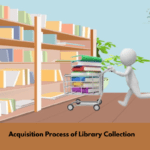Collection development is a crucial process in the library and information science field, focusing on the acquisition and organization of library materials that cater to the diverse needs of library users. The International Federation of Library Associations and Institutions defines collection development as spanning a variety of themes, particularly those pertinent to training materials. This comprehensive approach includes not only the procurement of tangible items such as books, magazines, and journals but also extends to the acquisition of electronic resources, including documents, databases, and licensed digital materials.

Key Elements of Collection Development
The collection development process is ongoing and consists of six key elements or stages:
1. User Needs Assessment: This stage involves conducting a thorough analysis of the targeted user population to identify their specific informational needs. Known also as community analysis, this process seeks to understand the demographics, preferences, and requirements of library users. Employing user studies and information needs assessments allows libraries to tailor their collections effectively to support the community’s academic, recreational, and informational pursuits.
2. Policy Development: Establishing a collection development policy is considered a best practice for libraries, archives, and information centers. This policy outlines the criteria, goals, and guidelines for selecting and acquiring materials, ensuring that the collection reflects the community’s needs and aligns with the library’s mission. It serves as a framework for decision-making and helps maintain consistency in how materials are added to or removed from the collection.
3. Selection: The selection process is dynamic, requiring ongoing input and collaboration from various stakeholders, including faculty members, administrative management, and library users. Engaging these groups ensures that the selection reflects a comprehensive range of interests and academic disciplines, enhancing the relevance and utility of the library’s offerings. This collaborative approach fosters a sense of community ownership over the library’s collection.
4. Acquisition: Acquisition entails the procurement of materials for the library’s collection, which includes purchasing books, e-books, periodicals, databases, and other resources. This stage involves not just the financial transactions but also the logistical aspects of preparing these materials for user access. Librarians must ensure that the acquired items are cataloged efficiently, processed, and made readily available for utilization by patrons, enhancing the overall user experience.
5. Weeding: Often referred to as reading or reaccessioning, this stage involves the systematic removal of outdated, damaged, or seldom-used materials from the library collection. Weeding is essential to create space for new acquisitions and to ensure the collection remains current and relevant. By maintaining an updated collection, libraries can better meet the evolving interests and needs of their users, allowing for a more engaging and informative environment.
6. Evaluation: The evaluation stage focuses on analyzing the utilization and engagement statistics of the collection. By reviewing circulation data, patron feedback, and usage trends, librarians can assess the effectiveness of their collection development efforts. This analysis is crucial for understanding changing reading habits and curriculum demands, allowing libraries to adapt and refine their strategies actively. Regular evaluations help libraries to develop future plans that align with the shifting landscape of information needs, ensuring that their collections remain relevant and impactful.
Through these six stages, collection development emerges as a comprehensive and systematic approach that allows libraries to effectively respond to the needs of their communities while fostering lifelong learning and exploration.
Methods of Collection Development
There are five distinct methods of collection development that libraries can employ to enhance their resources:
1. Purchase
The purchase method stands as the foundational approach to library collection development. Through this technique, libraries allocate a specific budget to acquire new materials, including books, journals, and digital content. Libraries can source these items from various vendors, both local and international. The selection process often involves assessing the needs of the library’s user community, ensuring that acquisitions align with the diverse interests and educational requirements of its patrons.
2. Gift or Donation
Gifts and donations represent another vital strategy for enriching a library’s collection. This method relies on contributions made by library patrons, local organizations, or philanthropic individuals. Gifts can take various forms, including monetary donations or actual physical materials such as books and periodicals. Such contributions often reflect the interests of the donors and can diversify the collection, providing unique resources that may not be achievable through purchasing alone. Engaging the community in this way fosters a sense of ownership and involvement in the library’s mission.
3. Exchange
The exchange method involves the collaborative sharing of library materials among institutions, organizations, and governmental entities. Through reciprocal agreements, libraries can trade surplus materials with one another, effectively expanding their collections without incurring additional costs. This approach not only enhances the diversity of available resources but also promotes a spirit of cooperation and inter-library solidarity, maximizing access to a broader range of materials for users.
4. Institutional Membership
By acquiring institutional memberships with various national and international organizations, libraries can gain access to an extensive array of both printed and electronic resources. These memberships often yield significant benefits, including free or discounted access to scholarly journals, databases, and other essential academic materials. This method ensures that libraries can keep their collections relevant and comprehensive, supporting research and study across multiple disciplines.
5. Deposit Systems
Under the deposit system, libraries receive publication copies from government agencies, as well as national and international organizations, as part of their mandate to disseminate knowledge. This system often includes new publications and important documents that contribute to the development of a library’s collection. For instance, universities may gain access to research documents while public libraries might receive government publications, ensuring that users have access to valuable and current materials.
Advantages of Collection Development
There are four primary advantages of engaging in effective collection development within libraries:
1. Expanded Subject Scope
The scope of subjects available in libraries is significantly broadened through collection development. Libraries are equipped to cover a range of topics, from basic introductory materials to in-depth scholarly works. This variety caters to different demographics, ensuring that general readers find accessible information while scholars and researchers access specialized texts that support their studies.
2. Up-to-Date Knowledge
Libraries continually update their knowledge resources through regular acquisitions. The introduction of new editions and the latest versions of existing materials ensure that patrons benefit from current information, reflecting advancements in various fields. This commitment to staying current helps maintain the library as a vital hub for learning and research.
3. Meeting User Needs
A strategic collection development process directly addresses the needs and preferences of library users. By curating materials that reflect what patrons wish to read or study, libraries send a positive message about their responsiveness to community interests. This focus on user satisfaction enhances the library’s reputation and encourages continued patron engagement.
4. Resource Sharing
A well-developed collection facilitates greater resource sharing and interlibrary loans, both of which are essential for optimizing access to information. Libraries can think beyond their collections, collaborating with other institutions to provide patrons with a wider range of materials. This cooperative approach not only strengthens relationships among libraries but also maximizes the effectiveness of shared resources for the benefit of all users.
Collection development involves systematically selecting, acquiring, and evaluating library resources to meet user needs, using various methods such as user feedback, data analysis, and expert judgment, offering advantages like improved resource relevance, efficient budgeting, and enhanced user satisfaction.



